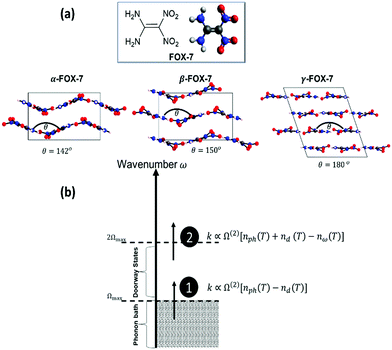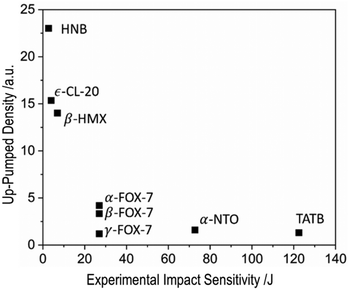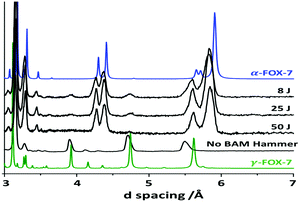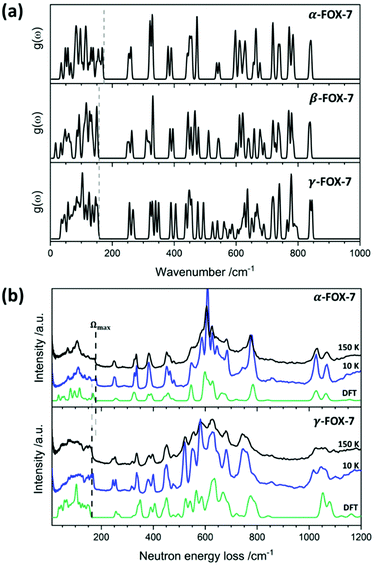 Open Access Article
Open Access ArticleCreative Commons Attribution 3.0 Unported Licence
Predicting the impact sensitivity of a polymorphic high explosive: the curious case of FOX-7†
Adam A. L.
Michalchuk
 *a,
Svemir
Rudić
*a,
Svemir
Rudić
 b,
Colin R.
Pulham
b,
Colin R.
Pulham
 c and
Carole A.
Morrison
c and
Carole A.
Morrison
 *c
*c
aFederal Institute for Materials Research and Testing (BAM), Richard Wilstaetter Str 11, 12489, Berlin, Germany. E-mail: adam.michalchuk@bam.de
bISIS Neutron and Muon Source, STFC, Rutherford Appleton Laboratory, Chilton, Didcot, OX11 0QX, UK
cEaStCHEM School of Chemistry and Centre for Science at Extreme Conditions, University of Edinburgh, EH9 3FJ, Edinburgh, UK. E-mail: carole.morrison@ed.ac.uk
First published on 1st October 2021
Abstract
The impact sensitivity (IS) of FOX-7 polymorphs is predicted by phonon up-pumping to decrease as layers of FOX-7 molecules flatten. Experimental validation proved anomalous owing to a phase transition during testing, raising questions regarding impact sensitivity measurement and highlighting the need for models to predict IS of polymorphic energetic materials.
Understanding molecular mechano-chemical reactivity has been the focus of research into energetic materials (EMs) for over 75 years.1 EMs are able to convert mechanical energy into a chemical response, thereby resulting in their widespread uses across military and civilian applications. From a technological perspective, the response of EMs to mechanical impact – impact sensitivity (IS) – is arguably the most critical parameter. EMs which initiate under mild impact (i.e. are sensitive) pose great risk to safety and are often not suitable for real-world applications. Determining the IS of new EMs is paramount to developing new materials with targeted applications.
Established IS testing protocols are based on the drop-hammer approach, but are known to produce widely varying results. These variations derive from numerous, often poorly controllable, experimental parameters, including particle size, defect concentration, and the presence of impurities. For example, the reported impact sensitivity of FOX-7 (1,1-diamino-2,2-dinitroethene, DADNE, Fig. 1) ranges from 11 J through to 30 J.2 Understanding this variability is further complicated by literature reports quoting IS values in two different ways: (1) limiting impact energy, E0, below which no impacts lead to initiation, and (2) the energy at which 50% of impacts lead to initiation, E50. Correspondingly, significant efforts have been devoted to establishing theoretical approaches to screen IS in silico.3–5
 | ||
| Fig. 1 Description of the model used in this work. (A) Chemical and crystallographic structures of FOX-7, including α-FOX-7(P21/n); β-FOX-7 (P212121) and γ-FOX-7 (P21/n). Atoms are coloured as (red) oxygen; (blue) nitrogen; (grey) carbon, and (white) hydrogen. (B) Mechanism of multi-phonon up-pumping. (1) Phonons scatter at a rate proportional to the two-phonon density of states Ω(2) and the Planck–Einstein populations of the phonon (nph) and doorway modes (nd). (2) Doorway states scatter upwards into molecular modes with populations nω. Further mathematical details are given in ESI,† S3 and ref. 17. | ||
Theoretical screening methods have typically involved the study of isolated gas-phase molecules.6 Despite their predictive power, their simplicity renders gas-phase models unable to capture key experimental findings. Notably, EM mechano-chemical reactivity depends intimately on crystal packing,7 and varies across polymorphs8 and multi-component materials.9 Moreover, it is a well-known fact, albeit poorly understood, that EMs with layered crystal structures are generally less sensitive to mechano-chemical stimuli. This is exemplified by the prototypic insensitive layered EM, TATB (1,3,5-triamino-2,4,6-trinitro-benzene). It has been postulated that this decreased sensitivity stems from dissipation of mechanochemical energy associated with slippage of the layers.10–12 However, as evidenced by the highly sensitive layered material, hexanitrobenzene, the extent of crystallographic layering and hence ease of slippage is not the complete story.13
Unfortunately, comparing the mechano-chemical reactivity of layered and non-layered EMs usually involves the study of two different energetic molecules. This makes it difficult to identify the origin of low sensitivity as being molecular or structural in nature. However, the thermally accessible polymorphs of FOX-7 offer an excellent route to bypass this problem, Fig. 1a. At ca. 115 °C the thermodynamically stable α-FOX-7 converts to β-FOX-7, and subsequently to γ-FOX-7 at ca. 173 °C.14,15 Importantly, the layers of FOX-7 molecules become increasingly flattened across these transitions. By combining advanced simulation and experiment we herein investigate how crystallographic packing in FOX-7 affects IS properties of the same energetic molecule. In doing so, we consider the reliability of standard testing protocol for measuring IS of polymorphic materials.
We have reported recently the development of a successful IS prediction model13,16,17 rooted in the fundamental concepts of vibrational energy transfer: phonon up-pumping.18 In this model, Fig. 1b and ESI,† S3, the mechanical impact superheats the crystal lattice vibrations via adiabatic compression. The equilibrated crystal temperature of an adiabatically compressed crystal long after impact, Tf, depends on the compression associated with the impact, V/V0, and the material Gruneissen parameter (γ),
 | (1) |
 | (2) |
Phonon–phonon scattering facilitates the transfer of excess energy from the superheated phonon bath (ω < Ωmax) into localised molecular vibrations (ω > Ωmax). Assuming Einstein phonons, the rate of phonon up-pumping (τ) follows according to
| τ ∝ V(3)δ(−ω1 − ω2 + Ω) | (3) |
To explore an up-pumping based model of IS for the FOX-7 polymorphs using our recent developments,17 we computed the zone-centre (Γ-point) phonon spectra, Fig. 2a, for each of the polymorphic forms at the PBE-D2 level of Density Functional Theory (see full computational details in ESI,† S1). Additionally, we successfully prepared a sample of γ-FOX-7 according to the procedures reported by Crawford et al.14 It was therefore possible to measure inelastic neutron scattering (INS) spectra for each of α- and γ-FOX-7 against which to validate our DFT models. Unfortunately, attempts to prepare stable samples of β-FOX-7 were not successful, with the sample reverting to α-FOX-7 upon cooling. Our DFT models reproduced the INS spectra well, but appear to routinely slightly underestimate the value of Ωmax for each polymorph as compared with the low temperature (10 K) INS spectra, Fig. 2b (α-FOX-7 exp (10 K) = 182 cm−1, DFT-D = 175 cm−1; γ-FOX-7 exp (10 K) = 172 cm−1, DFT-D = 160 cm−1). Reassuringly, INS spectra collected at elevated temperatures (150 K) show a softening of Ωmax with no change in vibrational bands at higher wavenumbers. Hence, we can conclude that our simulated spectra agree well with the vibrational spectra of FOX-7 polymorphs under realistic testing conditions, thereby validating the vibrational frequencies used for our up-pumping model.
The vibrational spectra are similar for all three polymorphs, but with one striking variation. As the layers of FOX-7 molecules flatten in the crystal structure, the frequency of the vibrational bands at the top of the phonon bath (Ωmax) soften – see Table 1 and Fig. 2a. This reflects a decrease in the strength of the interlayer interactions. According to eqn (3), a decrease in Ωmax has the effect of reducing the number of states accessible through qqQ coupling, thereby reducing the rate of up-pumping. For a unit cell comprising Z molecules, the relative rate of up-pumping is reflected in the density of phonon states  in the doorway region, which for the polymorphs of FOX-7 scale as α-FOX-7 > β-FOX-7 > γ-FOX-7, see Table 1 and ESI,† S4. This in turn suggests two potential structural features for tuning the sensitivities of EMs. While the decrease in DOPS from α to β-FOX-7 is a direct reflection of the softening of Ωmax, the further decrease from β to γ FOX-7 likely corresponds to an increase in Z (i.e. the number of energy-absorbing molecules; see crystal structures in Fig. 1a). Similar correlations based on DOPS for molecular EMs have been previously suggested.13,20,21
in the doorway region, which for the polymorphs of FOX-7 scale as α-FOX-7 > β-FOX-7 > γ-FOX-7, see Table 1 and ESI,† S4. This in turn suggests two potential structural features for tuning the sensitivities of EMs. While the decrease in DOPS from α to β-FOX-7 is a direct reflection of the softening of Ωmax, the further decrease from β to γ FOX-7 likely corresponds to an increase in Z (i.e. the number of energy-absorbing molecules; see crystal structures in Fig. 1a). Similar correlations based on DOPS for molecular EMs have been previously suggested.13,20,21
| Polymorphic form | |||
|---|---|---|---|
| α | β | γ | |
| Ω max/cm−1 | 175 | 160 | 160 |
| DOPS/10−2 | 1.71 | 1.14 | 0.66 |
| C ph/J K−1 mol−1 | 68.57 | 68.57 | 72.72 |
| C tot/J K−1 mol−1 | 342.76 | 342.43 | 346.63 |
| C ph/Ctot | 5.00 | 5.00 | 4.77 |
| T shock/K | 3278.0 | 3278.0 | 3120.7 |
We explore further the prediction of IS for FOX-7 polymorphs using the complete vibrational up-pumping model. From our simulated vibrational frequencies, values for bulk Ctot and phonon bath Cph were calculated, Table 1 and ESI,† S4, and the initial conditions for ϕph were derived from their ratio, eqn (2). In the high temperature limit, each vibration contributes kBT to Ctot. Correspondingly, the theoretical heat capacity for each polymorph is expected to be equal. The small discrepancy observed in our case does not however affect the up-pumping simulations (see ESI,† S5). Our up-pumping calculations were performed using the two-step model outlined in Fig. 1b, at a bulk equilibrium temperature of 300 K. The resulting relative IS for the three FOX-7 polymorphs are shown in Fig. 3, alongside the corresponding values for a range of EMs that we have reported previously.17 Our predictions suggest that as layers of FOX-7 molecules become flattened, the sensitivity decreases. Moreover, the up-pumping prediction for γ-FOX-7 (which contains flat molecular layers) places it in line with the prototypical insensitive layered EM, TATB. From the success of our model, the reason for desensitisation of layered EMs becomes clear: given that our model only considers the up-pumping of energy through the vibrational DOS, it must be the changes in the vibrational DOS, induced by changes in the crystal packing, which alter the impact sensitivity metric.
 | ||
| Fig. 3 Multi phonon up-pumped values for three FOX-7 polymorphs and a range of well-known EMs taken from ref. 17. A full description of the simulated FOX-7 values is given in ESI,† S5. In the absence of available data, the three polymorphs of FOX-7 have been plotted at the experimental sensitivity of α-FOX-7. | ||
To validate our up-pumping predicted IS, we attempted to measure the experimental values of IS for both the α- and γ-polymorphic forms. We note that the experimental IS of α-FOX-7 has been documented widely. Typical E50 values of 24–30 J are reported, although indications of IS as low as 10–11 J are also known.2 To the best of our knowledge, drop hammer testing of γ-FOX-7 has not yet been reported. Here, samples of both α- and γ-FOX-7 were subjected to impact sensitivity testing using the BAM fall-hammer limiting impact ‘go/no-go’ criteria. Hence, our values are indicative of E0.
The sample of α-FOX-7 tested in this way (see ESI,† S6) suggested E0 ≈ 8 J. The significantly smaller initiation energy of E0versus E50 is expected. Contrary to up-pumping predictions, and to the widely held view that layered material are insensitive to impact, BAM fall hammer testing of γ-FOX-7 did not indicate reduced sensitivity as compared with the α-form. Instead, the same value of E0 was obtained as for α-FOX-7, to within the experimental error of the measurement (see ESI,† S6).
To explore this paradox in further detail, samples of γ-FOX-7 which did not initiate upon impact were analysed by powder X-ray diffraction, and compared to simulated patterns of pure α- and γ-FOX-7, Fig. 4. Remarkably, all samples of γ-FOX-7 which were exposed to mechanical impact had converted back to the α-phase. In contrast, samples of γ-FOX-7 that were not exposed to testing did not convert, even after 72 hour storage under ambient conditions. Hence, the observed polymorphic transformation did not result from handling or storage of γ-FOX-7. While we cannot discount entirely the role of defects or particle structure in dictating the observed sensitivity, we suggest that the seemingly identical IS values of the herringbone (α) and layered (γ) phases of FOX-7 were likely to be the result of an impact-induced phase transition. This transition may be the observed γ → α phase transition or could include an intermediate layering of the α-phase upon impact; the latter is plausible given that the layering of FOX-7 is known to increase with pressure.22 Moreover, it remains unclear whether the impact, local heating, or interparticle friction is responsible for the transformation. Further shock compression studies are required to better understand this fascinating phenomenon. It is, however, clear that the results of current BAM fall hammer testing protocol should be interpreted with caution, particularly when dealing with polymorphic EMs. To the best of our knowledge this represents the first example of BAM hammer induced-polymorphism during IS testing. Given the wide-spread presence of polymorphism in EMs we do not expect this to be an isolated phenomenon.
 | ||
| Fig. 4 PXRD profiles for FOX-7 before and after BAM hammer treatment (see ESI,† S6), with that for a sample stored at room conditions for three days without BAM Hammer testing. Simulated patterns for α-FOX-7 (blue) and -FOX-7 (green) are shown for comparison. Note a small offset in the position of the experimental peak of γ-FOX-7 at d ≈ 5.5 Å, which corresponds to the crystallographic (0 0 2) plane. This offset is due to a minor misalignment of the diffractometer and sample geometry. | ||
In summary, we have explored the variation in impact sensitivity across three polymorphic forms of the high explosive FOX-7: α, β, and γ. Using a theoretical model based on vibrational up-pumping, we predict that the increased layering of the polymorphs reduces the impact sensitivity. This is consistent with trends in EM research which suggest that layered materials exhibit reduced sensitivity. Experimental validation of the up-pumping model was sought using BAM fall hammer testing. For the first time, the impact sensitivity of a sample of γ-FOX-7 was measured. However, in stark contrast to prevailing thought, and the up-pumping predictions reported herein, the layered γ-form exhibited an identical impact sensitivity as the herringbone α-form. Ex situ powder X-ray diffraction showed that γ-FOX-7 converts to the α-form under BAM fall hammer impact. We suggest this transition to be responsible for the seemingly paradoxical impact sensitivity results. Although this is the first reported case of a fall hammer-induced polymorphic transition, it is surely not an isolated case: the academic literature cites many examples of pressure-induced polymorphism in EMs.23 Thus this work further highlights the need for robust theoretical platforms on which to screen and explore mechano-chemical responses of EMs, in order that structure–property relationships are properly understood.
INS measurements were performed on the TOSCA24–26 instrument at ISIS Neutron and Muon Facility (RB1710382). The authors thank BAM IT for access to computational resources and to Dr D. Williamson (University of Cambridge) for access to the BAM Fall Hammer. We are also grateful for computational support from the United Kingdom Materials and Molecular Modelling Hub, which is partially funded by EPSRC (EP/P020194 and EP/T022213), for which access was obtained via the UKCP consortium and funded by EPSRC grant ref EP/P022561/1.
Conflicts of interest
There are no conflicts to declare.References
- R. B. Parlin, G. Duffy, R. E. Powell and H. Eyring, The Theory of Explosion Initiation, National Defense Research Committee of the Office of Scientific Research and Development, 1943 Search PubMed.
- W. Trzciński and A. Belaada, Cent. Eur. J. Energ. Mater., 2016, 13, 527–544 CrossRef.
- R. Tsyshevsky, O. Sharia and M. Kuklja, Molecules, 2016, 21, 236 CrossRef PubMed.
- S. V. Bondarchuk, New J. Chem., 2019, 43, 1459–1468 RSC.
- D. Mathieu, Ind. Eng. Chem. Res., 2017, 56, 8191–8201 CrossRef CAS.
- B. M. Rice and J. J. Hare, J. Phys. Chem. A, 2002, 106, 1770–1783 CrossRef CAS.
- Y. Ma, A. Zhang, X. Xue, D. Jiang, Y. Zhu and C. Zhang, Cryst. Growth Des., 2014, 14, 6101–6114 CrossRef CAS.
- B. Asay, B. Henson, L. Smilowitz and P. M. Dickson, J. Energ. Mater., 2003, 21, 223–235 CrossRef CAS.
- S. R. Kennedy and C. R. Pulham, in Monographs in Supramolecular Chemistry, ed. C. B. Aakeröy and A. S. Sinha, Royal Society of Chemistry, Cambridge, 2018, pp. 231–266 Search PubMed.
- Y. Ma, A. Zhang, C. Zhang, D. Jiang, Y. Zhu and C. Zhang, Cryst. Growth Des., 2014, 14, 4703–4713 CrossRef CAS.
- J. Zhang, L. A. Mitchell, D. A. Parrish and J. M. Shreeve, J. Am. Chem. Soc., 2015, 137, 10532–10535 CrossRef CAS PubMed.
- R. Bu, W. Xie and C. Zhang, J. Phys. Chem. C, 2019, 123, 16014–16022 CrossRef CAS.
- A. A. L. Michalchuk, M. Trestman, S. Rudić, P. Portius, P. T. Fincham, C. R. Pulham and C. A. Morrison, J. Mater. Chem. A, 2019, 7, 19539–19553 RSC.
- M.-J. Crawford, J. Evers, M. Göbel, T. M. Klapötke, P. Mayer, G. Oehlinger and J. M. Welch, Propellants, Explos., Pyrotech., 2007, 32, 478–495 CrossRef CAS.
- J. Evers, T. M. Klapötke, P. Mayer, G. Oehlinger and J. Welch, Inorg. Chem., 2006, 45, 4996–5007 CrossRef CAS PubMed.
- A. A. L. Michalchuk, P. T. Fincham, P. Portius, C. R. Pulham and C. A. Morrison, J. Phys. Chem. C, 2018, 122, 19395–19408 CrossRef CAS.
- A. A. L. Michalchuk, J. Hemingway and C. A. Morrison, J. Chem. Phys., 2021, 154, 064105 CrossRef CAS PubMed.
- D. D. Dlott and M. D. Fayer, J. Chem. Phys., 1990, 92, 3798–3812 CrossRef CAS.
- S. Califano, V. Schettino and N. Neto, Lattice Dynamics of Molecular Crystals, Springer-Verlag, Berlin, Heidelberg, 1981 Search PubMed.
- J. Bernstein, J. Chem. Phys., 2018, 148, 084502 CrossRef PubMed.
- S. Ye, K. Tonokura and M. Koshi, Combust. Flame, 2003, 132, 240–246 CrossRef CAS.
- S. Hunter, P. L. Coster, A. J. Davidson, D. I. A. Millar, S. F. Parker, W. G. Marshall, R. I. Smith, C. A. Morrison and C. R. Pulham, J. Phys. Chem. C, 2015, 119, 2322–2334 CrossRef CAS.
- F. P. A. Fabbiani and C. R. Pulham, Chem. Soc. Rev., 2006, 35, 932 RSC.
- D. Colognesi, M. Celli, F. Cilloco, R. J. Newport, S. F. Parker, V. Rossi-Albertini, F. Sacchetti, J. Tomkinson and M. Zoppi, Appl. Phys. A: Mater. Sci. Process., 2002, 74, s64–s66 CrossRef CAS.
- S. F. Parker, F. Fernandez-Alonso, A. J. Ramirez-Cuesta, J. Tomkinson, S. Rudic, R. S. Pinna, G. Gorini and J. Fernández Castañon, J. Phys.: Conf. Ser., 2014, 554, 012003 CrossRef.
- R. S. Pinna, S. Rudic, S. F. Parker, M. Zanetti, G. Škoro, S. P. Waller, C. A. Smith, M. J. Capstick, D. J. McPhail, D. E. Pooley, G. D. Howells, G. Gorini and F. Fernandez-Alonso, Nucl. Instrum. Methods Phys. Res., Sect. A, 2018, 896, 68–74 CrossRef CAS.
Footnote |
| † Electronic supplementary information (ESI) available. See DOI: 10.1039/d1cc03906g |
| This journal is © The Royal Society of Chemistry 2021 |

